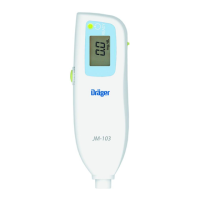DRAFT 20 June 2005
Jaundice Meter Instructions for Use (MU01380) Page 2 - 3
SPECIFICATIONS
subcutaneous tissue passes through the inner core, or short-optical path,
of the fiber. The part scattered from the deep areas of the subcutaneous
tissue passes through the outer core, or long-optical path, and then
reaches its corresponding photodiode.
By calculating the difference in the optical densities, the parts that are
common to the epidermis and dermis are deducted, and as a result, the
difference in the optical densities between the two wavelength regions
can be obtained for the subcutaneous tissue only. Since the optical
density difference shows a linear correlation with the total serum
bilirubin concentration, it is converted to the estimated bilirubin
concentration and is indicated digitally.
The Jaundice Meter device software uses a correlation coefficient to
convert the measurement difference from the dual optical path to an
estimated bilirubin concentration. The calculation formula used includes
the correlation coefficients α and γ. These coefficients were determined
in pre-clinical testing. The equation used is as follows:
J
sample
= α(L-S) + γ
Where L and S are the long and short optical path measurements.

